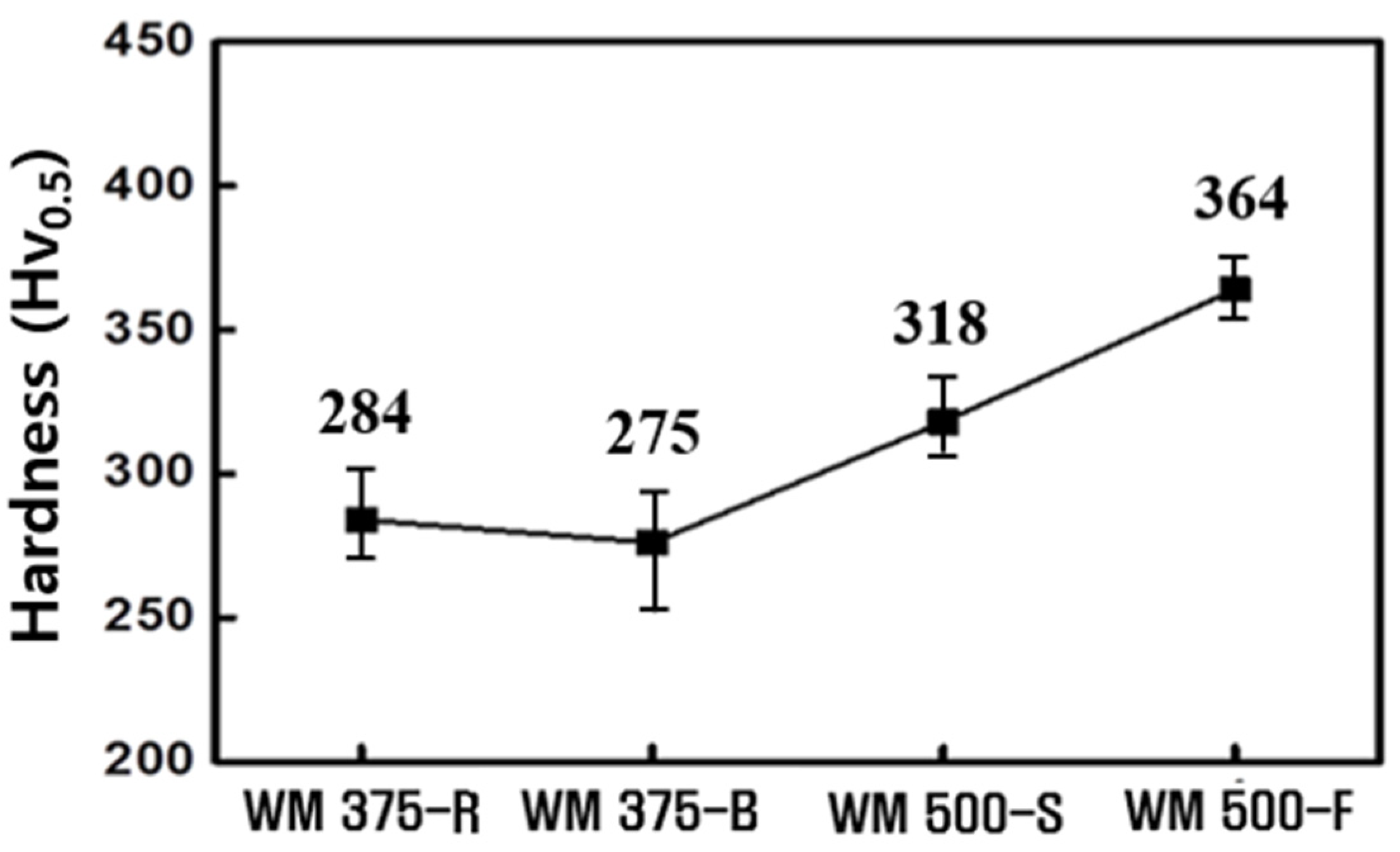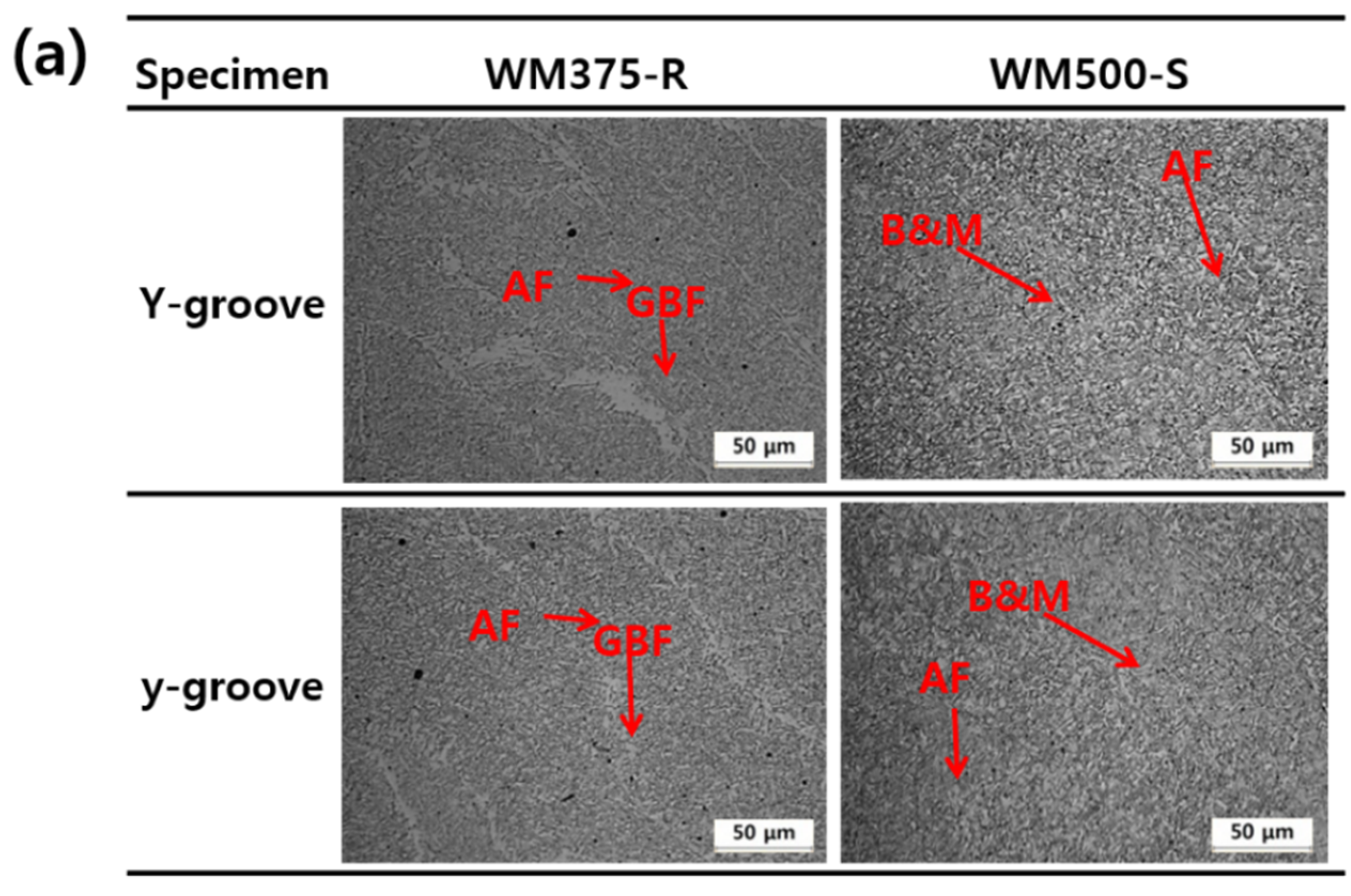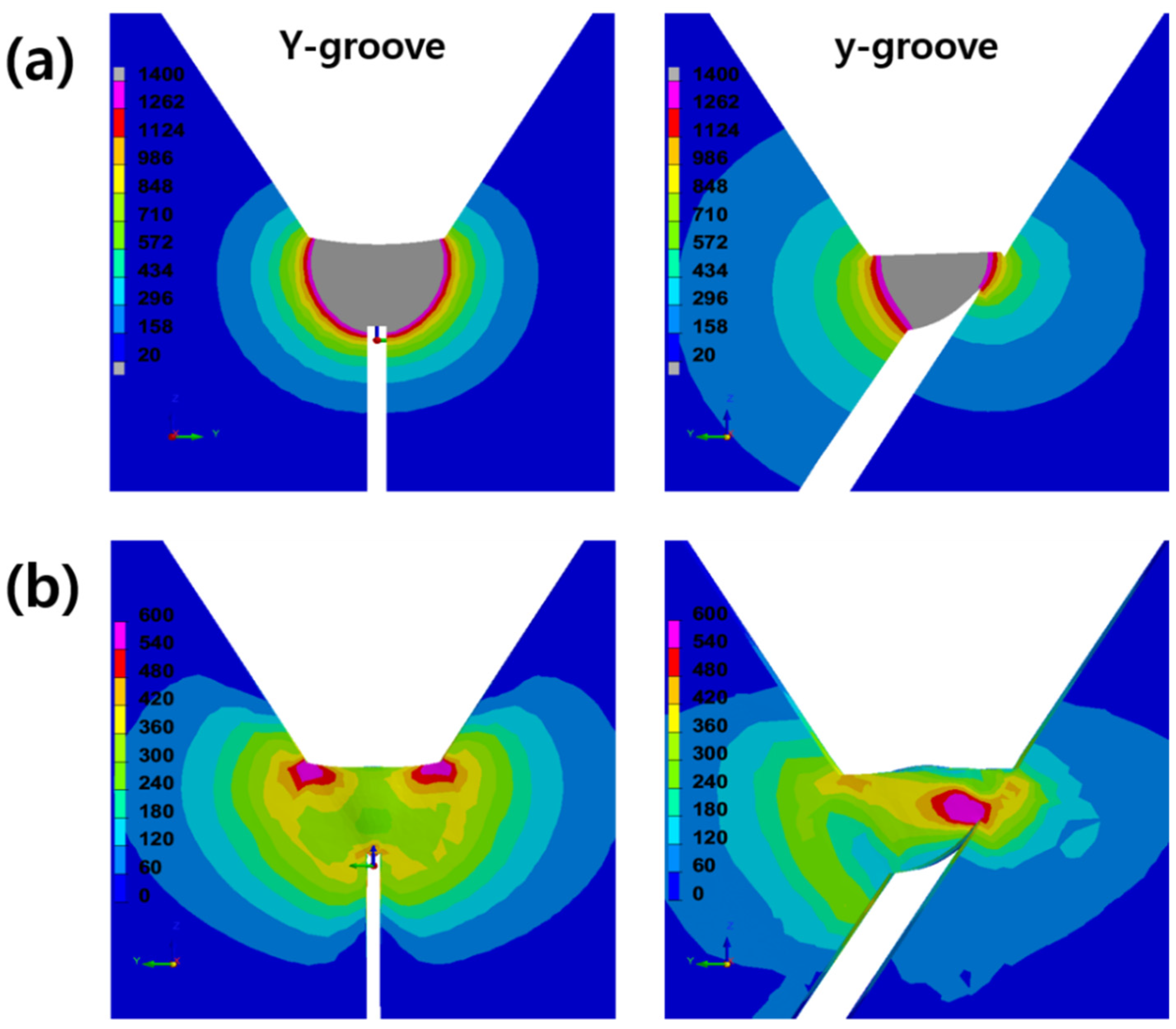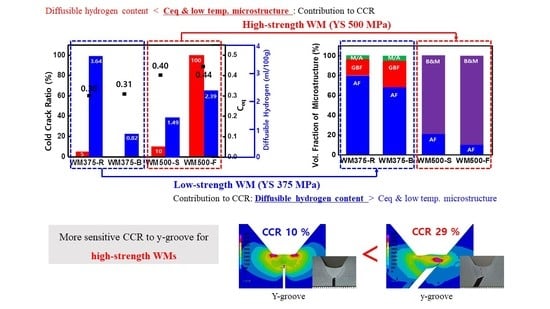Comprehensive Analysis of Cold-Cracking Ratio for Flux-Cored Arc Steel Welds Using Y- and y-Grooves
Abstract
:1. Introduction
2. Materials and Experimental Procedures
- The initial temperature of the model is 20 °C.
- The fluid flow in the molten pool is negligible.
3. Results and Discussion
3.1. Effect of Alloying Constituent and Diffusible Hydrogen Content on Cold Cracking for Y-Groove Test
3.2. Effect of Groove Shape on Cold Cracking
4. Conclusions
- (1)
- The low-strength-grade specimens, WM375-R and WM375-B, had an almost identical Ceq (0.3–0.31). WM375-B had a higher fraction of GBF and was more vulnerable to cold cracking than WM375-R. However, because WM375-R exhibited higher diffusible hydrogen content than WM375-B, the CCR of WM375-R was higher than that of WM375-B. The diffusible hydrogen content has a significant effect on cold cracking in low-strength WMs (YS 375 MPa).
- (2)
- The high-strength-grade specimens, WM500-S and WM500-F, had almost the same Ceq (0.4–0.44). Moreover, WM500-F had a greater hydrogen content and martensite/bainite fraction than WM500-S. Therefore, WM500-F exhibited a large CCR. The diffusible hydrogen content and the martensite/bainite fraction have a combined effect on the cold cracking of high-strength welds (YS 500 MPa).
- (3)
- With an increase in the strength grade of the WM, the fractions of martensite (M) and bainite (B), which render the WM vulnerable to cold cracking, increase. The increased fractions of M and B increase the hardness and CCR of the WM.
- (4)
- The low-strength WMs exhibited similar CCRs regardless of the Y/y-groove shape. However, for the high-strength WMs, the y-groove was simulated to have significant and unsymmetrical restraining stress exerted on the sharp root notch shape, therefore increasing the CCR experimentally. The Y/y-groove shape has a serious effect on cold cracking in high-strength WMs (YS 500 MPa).
- (5)
- The current shipbuilding industry requires high-strength WMs. Therefore, for the welding of high-strength steel, it is necessary to select WMs with a low content of diffusible hydrogen and M and/or B to minimize cold cracking. Furthermore, the groove shape for CCR testing should be decided based on the morphology of real welds because the restraining stress, which depends on the groove shape, directly controls the occurrence of cold cracking.
Author Contributions
Funding
Institutional Review Board Statement
Informed Consent Statement
Data Availability Statement
Acknowledgments
Conflicts of Interest
References
- Kumar, S.; Kwon, H.T.; Choi, K.H.; Cho, J.H.; Lim, W.; Moon, I. Current status and future projections of LNG demand and supplies: A global prospective. Energy Policy 2011, 39, 4097–4104. [Google Scholar] [CrossRef]
- Kim, J.H.; Choi, S.W.; Park, D.H.; Lee, J.M. Charpy impact properties of stainless steel weldment in liquefied natural gas pipelines: Effect of low temperatures. Mater. Des. 2015, 65, 914–922. [Google Scholar] [CrossRef]
- Lee, S.H.; Kim, K.H.; Van, D.H.; Nam, S.W. Effect of C-Mn ratio on the maximum hardness and toughness in TMCP steels with an identical carbon equivalent. J. Mater. Res. Technol. 2020, 9, 8916–8928. [Google Scholar] [CrossRef]
- Ryu, K.M.; Kim, D.W.; Lee, J.W.; Bang, H.C.; Park, C.G.; Jeong, H. High Heat Input Electro-gas Arc Welding of TMCP Plate for Steel Storage Tanks. J. Weld. Join. 2017, 35, 27–31. [Google Scholar] [CrossRef] [Green Version]
- Lee, M.J.; Kang, N.H. The Effect of Microstructure on Cold Crack in High-Strength Weld Metal. J. Weld. Join. 2014, 32, 22–27. [Google Scholar]
- Lan, L.; Kong, X.; Hu, Z.; Qiu, C. Hydrogen-induced cold cracking in heat-affected zone of low-carbon high-strength steel. Philos. Mag. Lett. 2014, 94, 764–771. [Google Scholar] [CrossRef]
- Sun, J.; Hensel, J.; Nitschke-Pagel, T.; Dilger, K. Influence of Restraint Conditions on Welding Residual Stresses in H-Type Cracking H-Test Specimens. Materials 2019, 12, 2700. [Google Scholar] [CrossRef] [PubMed] [Green Version]
- Kromm, A.; Kannengiesser, T. Characterizing Phase Transformations of different LTT alloy and their effect on Residual Stresses and Cold Cracking. Weld. World 2011, 55, 48–56. [Google Scholar] [CrossRef]
- Dunne, D.P.; Hejazi, D.; Saleh, A.A.; Haq, A.J.; Calka, A.; Pereloma, E.V. Investigation of the effect of eletrolytic hydrogen charging of X70 steel: I. The effect of microstructure on hydrogen-induced cold cracking and blistering. Int. J. Hydrog. Energy 2016, 41, 12411–12423. [Google Scholar] [CrossRef]
- Park, H.J.; Park, C.H.; Lee, J.H.; Nam, H.B.; Moon, B.R.; Moon, Y.H.; Kang, N.H. Microstructural aspects of hydrogen stress cracking in seawater for low carbon steel welds produced by flux-cored arc welding. Mater. Sci. Eng. A 2021, 820, 1–11. [Google Scholar] [CrossRef]
- Chung, S.H.; Sohn, I.; Jeong, H.C. Development of Welding Flux to Reduce Hydrogen Embrittlement in Weld Zone. J. Weld. Join. 2019, 37, 15–20. [Google Scholar] [CrossRef]
- Brown, I.H. The role of microsegregation in centreline cold cracking of high strength low alloy steel weldments. Scr. Mater. 2006, 54, 489–492. [Google Scholar] [CrossRef]
- Lee, M.J.; Kang, N.H.; Liu, S.; Cho, K.M. Effects of inclusion size and acicular ferrite on cold cracking for high-strength steel welds of YS 600 MPa grade. Sci. Technol. Weld. Join. 2016, 21, 711–719. [Google Scholar] [CrossRef]
- Loder, D.; Michelic, S.K.; Bernhard, C. Acicular Ferrite Formation and Its Influencing Factors—A Review. J. Mater. Sci. Res. 2017, 6, 24–43. [Google Scholar] [CrossRef] [Green Version]
- Jacobo, L.R.; García-Hernández, R.; López-Morelos, V.M.; Contreras, A. Effect of Acicular Ferrite and Bainite in API X70 Steel Obtained after Applying a Heat Treatment on Corrosion and Cracking Behaviour. Met. Mater. Int. 2020, 1–15. [Google Scholar] [CrossRef]
- Xie, W.P.; Liu, R.P.; Wang, H.; Wei, Y.H. Effect of Deoxidizer on Microstructure and Mechanical Properties of Micro-Slag Gas-Shielded Flux-Cored Wire. Met. Mater. Int. 2021, 1–11. [Google Scholar] [CrossRef]
- Kang, Y.J.; Lee, C.H. Effect of Microstructure on Low-Temperature Impact Toughness of Multi-Pass Weld Metal of 1 GPa Class High Strength Steel. J. Weld. Join. 2021, 39, 233–238. [Google Scholar] [CrossRef]
- Kang, Y.J.; Lee, C.H. Nucleation Behavior of Acicular Ferrite in 1 GPa Class High Strength Steel Weld Metal. J. Weld. Join. 2019, 37, 21–26. [Google Scholar] [CrossRef]
- Shiraiwa, T.; Kawate, M.; Briffod, F.; Kasuya, T.; Manabu, E. Evaluation of hydrogen-induced cracking in high-strength steel welded joints by acoustic emission technique. Mater. Des. 2020, 190, 1–17. [Google Scholar] [CrossRef]
- Ma, H.; Tian, H.; Xin, J.; Cui, Z. Correlation between Microstructure and Hydrogen Degradation of 690 MPa Grade Marin Engineering Steel. Materials 2021, 14, 851. [Google Scholar] [CrossRef]
- Destructive Tests on Welds in Metallic Materials—Cold Cracking Tests for Weldments—Arc Welding Processes; ISO 17642-2; International Standard: Geneva, Switzerland, 2005; pp. 1–19.
- Lee, M.J.; Cho, K.M.; Kim, Y.D.; Kang, N.H. Effect of martensite on cold cracking in 600-MPa grade flux-cored arc weld metals using the Y-groove test. Weld. World 2015, 59, 647–654. [Google Scholar] [CrossRef]
- Lee, M.J.; Cho, K.M.; Kang, N.H. Effect of Preheat Temperature and Microstructure on Cold Cracking in 600 MPa Grade Flux Cored Arc Weld Metal. Korean. J. Met. Mater. 2016, 54, 252–260. [Google Scholar]
- Welding and Allied Processes—Determination of Hydrogen Content in Arc Weld. Metal; ISO 3690; International Standard: Geneva, Switzerland, 2012; pp. 1–23.
- Ahmad, A.S.; Wu, Y.; Gong, H.; Nie, L. Finite Element Prediction of Residual Stress and Deformation Induced by Double-Pass TIG Welding of Al 2219 Plate. Materials 2019, 12, 2251. [Google Scholar] [CrossRef] [PubMed] [Green Version]
- Yi, H.J.; Lee, Y.J.; Kim, J.Y.; Kang, S.S. Effect of microstructure and chemical composition on cold crack susceptibility of high-strength weld metal. J. Mater. Res. Technol. 2011, 25, 2185–2193. [Google Scholar] [CrossRef]
- Hart, P.H.M. Resistance to Hydrogen Cracking in steel Weld Metals. Weld. J. 1986, 65, 14–22. [Google Scholar]
- Klett, J.; Mattos, I.B.F.; Silva, R.H.G.; Hassel, T. Control of the diffusible hydrogen content in different steel phase through the targeted use of different welding consumables in underwater wet welding. Mater. Corros. 2021, 72, 504–516. [Google Scholar] [CrossRef]
- Mao, G.; Cao, R.; Yang, J.; Jiang, Y.; Wang, S.; Guo, X.; Yuan, J.; Zhang, X.; Chen, J. Effect of Nickel Contents on the Microstructure and Mechanical Properties for Low-Carbon Bainitic Weld Metal. J. Mater. Eng. Perform. 2017, 26, 2057–2071. [Google Scholar] [CrossRef]
- Kang, Y.J.; Jang, J.H.; Park, S.M.; Lee, C.H. Influence of Ni on the Microstructure and Mechanical properties of HSLA Steel Welds. J. Weld. Join. 2012, 30, 49–54. [Google Scholar] [CrossRef] [Green Version]










| Alloys | C | Si | Mn | Ni | Cr | Cu + Mo + B | Ceq | Pcm | HD (mL/100 g) |
|---|---|---|---|---|---|---|---|---|---|
| WM375-R | 0.05 | 0.73 | 1.40 | 0.02 | 0.04 | 0.03 | 0.30 | 0.15 | 3.64 |
| WM375-B | 0.07 | 0.64 | 1.41 | 0.01 | 0.02 | 0.03 | 0.31 | 0.16 | 0.82 |
| WM500-S | 0.06 | 0.32 | 1.37 | 1.37 | 0.01 | 0.27 | 0.40 | 0.19 | 1.49 |
| WM500-F | 0.06 | 0.37 | 1.37 | 2.07 | 0.01 | 0.02 | 0.44 | 0.20 | 2.39 |
| BM 235 | 0.16 | 0.28 | 0.68 | 0.01 | 0.02 | 0.01 | 0.28 | 0.20 | - |
| BM 500 | 0.06 | 0.20 | 1.54 | 0.19 | 0.22 | 0.35 | 0.42 | 0.19 | - |
| Model Parameters | Values |
|---|---|
| Material (base and weld metals) | Carbon steel |
| Ambient temperature (°C) | 20 |
| Element size (mm3) | ~0.3 |
| Heat source parameters (af + ar, b, c) | |
| af + ar | 5 mm |
| b | 5 mm |
| c | 3 mm |
Publisher’s Note: MDPI stays neutral with regard to jurisdictional claims in published maps and institutional affiliations. |
© 2021 by the authors. Licensee MDPI, Basel, Switzerland. This article is an open access article distributed under the terms and conditions of the Creative Commons Attribution (CC BY) license (https://creativecommons.org/licenses/by/4.0/).
Share and Cite
Nam, H.; Yoo, J.; Yun, K.; Xian, G.; Park, H.; Kim, N.; Song, S.; Kang, N. Comprehensive Analysis of Cold-Cracking Ratio for Flux-Cored Arc Steel Welds Using Y- and y-Grooves. Materials 2021, 14, 5349. https://doi.org/10.3390/ma14185349
Nam H, Yoo J, Yun K, Xian G, Park H, Kim N, Song S, Kang N. Comprehensive Analysis of Cold-Cracking Ratio for Flux-Cored Arc Steel Welds Using Y- and y-Grooves. Materials. 2021; 14(18):5349. https://doi.org/10.3390/ma14185349
Chicago/Turabian StyleNam, Hyunbin, Jaeseok Yoo, Kwanghee Yun, Guo Xian, Hanji Park, Namkyu Kim, Sangwoo Song, and Namhyun Kang. 2021. "Comprehensive Analysis of Cold-Cracking Ratio for Flux-Cored Arc Steel Welds Using Y- and y-Grooves" Materials 14, no. 18: 5349. https://doi.org/10.3390/ma14185349







